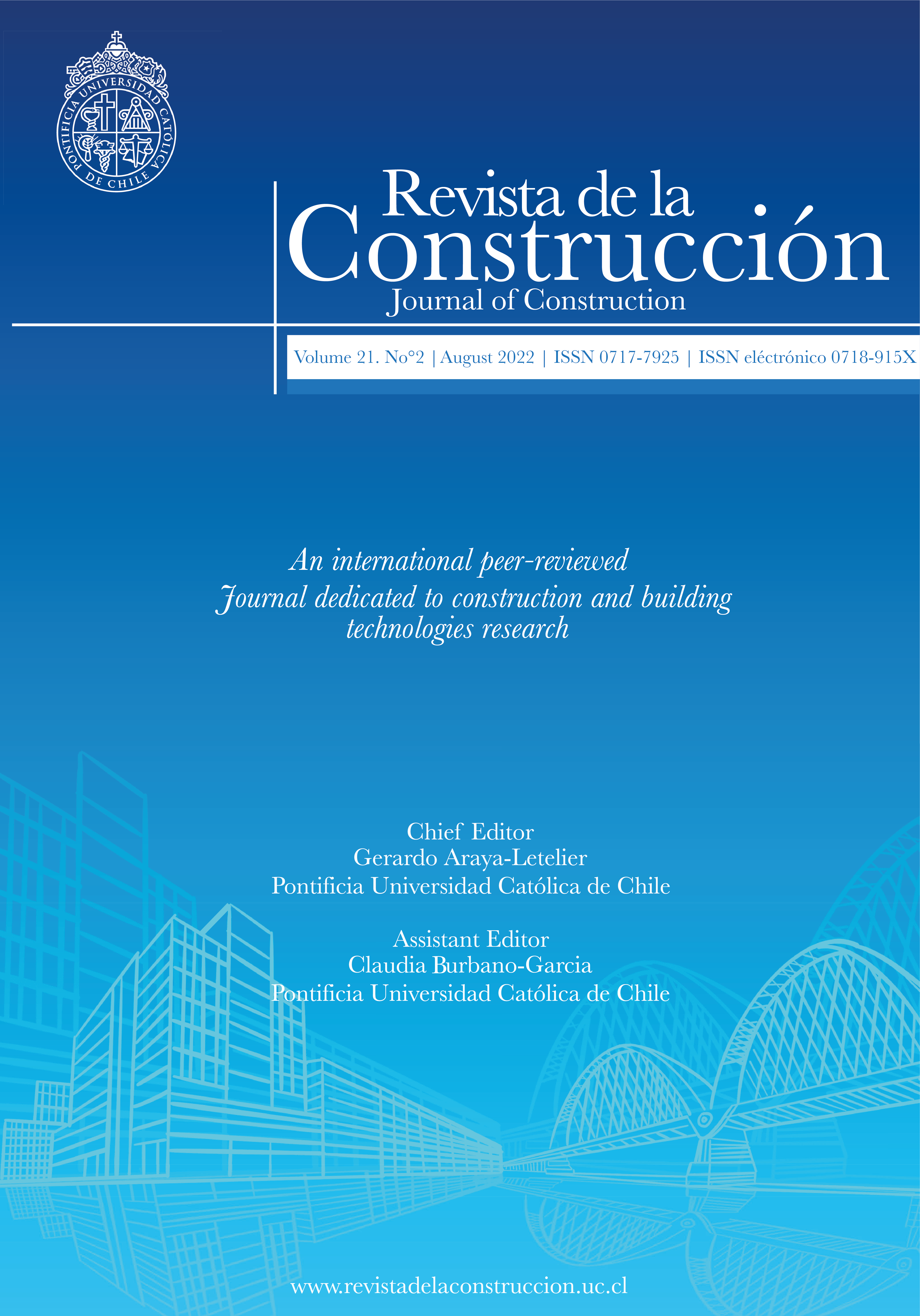The Construction sequence analysis of multi-storey setback building placed in slope with p-delta and time-dependent effects
DOI:
https://doi.org/10.7764/RDLC.21.2.408Keywords:
Construction Sequence, P-Delta, ETABS, Setback, timeAbstract
Analysis and design of the structure are the most critical steps in the pre-construction steps involved. Nowadays, as technology is well developed, there is plenty of software available to carry over the analysis and design of any structures in a short period. In every software, the building model with all storey will be modelled, and loads are applied to the modelled structure on respective members, and their responses will be studied for the whole structure. But in reality, the building will be constructed in sequence as a step-by-step process, i.e., storey after storey with their respective loads, which may produce different responses. This analysis with sequential loading at each step is called Construction Sequence Analysis (CSA). In the present project work, the ten-storey setback building with a built-up area of 25m x 30m placed on the slope of 10°, assumed to be situated in Darjeeling, is modelled in ETABS software. The loads, namely gravity and lateral loads are applied to the developed model. Then the model is analyzed for different loads and their combinations as prescribed by IS codes. The combinations that produce high response are selected and dead load in those combinations are replaced with three modes: CSA without P-Delta effect, CSA with P-Delta effect, and CSA with P-Delta and Time-dependent effects combined. Thus the model is analyzed with these three additional combinations along with selected conventional load combinations. The various comparisons such as storey displacement, and storey drift between these four combinations of analysis were studied, and results were discussed. The building design is also done based on the analysis performed.
Downloads
References
Chakrabarti, S.C., Nayak, G.C., &Agarwala, S.K. (2019). Effect of Sequence of Construction in the Analysis of Multistoreyed Building Frame. Building and Environment, 13(1), 1-6.
Cosgu, T., Sayin, B., &Gunes, B. (2022). A methodological approach for seismic performance of existing single-storey industrial RC precast facilities. Revista de la Construccion. Journal of Construction. 21(1), 167-183.
IS 1893-1 (2016). Criteria for Earthquake Resistant Design of Structures, Part 1: General Provisions and Buildings, Bureau of Indian Stand-ards, India.
IS 456 (2000). Code of Practice for Plain and Reinforced Concrete ( CED 2: Cement and Concrete), Bureau of Indian Standards, India.
IS 875-1 (1987). Code of Practice for Design Loads (Other than Earthquake) for buildings and structures, Part 1: Dead Loads- Unit weights of Building and Stored Materials, Bureau of Indian Standards, India.
IS 875-2 (1987). Code of Practice for Design Loads (Other than Earthquake) for buildings and structures, Part 2: Imposed Loads, Bureau of Indian Standards, India.
IS 875-3 (2015). Code of Practice for Design Loads (Other than Earthquake) for buildings and structures, Part 3: Wind Loads, Bureau of Indian Standards, India.
Kim, H.S., & Shin, S.H. (2011). Column Shortening Analysis with Lumped Construction Sequences. Procedia Engineering, 14, 1791-1798.
Kiran, Y.N., Laxmikant, V., &Gitadevi, B.B. (2017). Construction Sequence Analysis of Multistorey RCC Building. International Research Journal of Engineering and Technology, 4(7), 785-790.
Kwak, H.G., & Kim, J.K. (2006). Time-dependent Analysis of RC Frame Structures Considering Construction Sequence. Building and Envi-ronment, 41, 1423-1434.
Mathew, S.A., Parivalla, S. Ravisankar, K., &Kesavan, K. (2014). Elemental Modal Strain Energy for Damage Identification of a Space Frame: A Numerical Approach. International Journal of Applied Engineering Research, 9(17), 3723-3732.
Michele, F.G., Giuseppe, L., Antonino, R., & Marcello, A. (2018). Construction sequence analysis of long-span cable-stayed bridges. Engi-neering Structures, 174, 267-281.
Mohammad, J.A., Ali, K., & Majid, G. (2017). Simplified Sequential Construction Analysis of Buildings with the New Proposed Method. Structural Engineering and Mechanics, 63(1), 77-88.
National Building Code of India (2016). Volume 1, Bureau of Indian Standards, India.
Nayak, S.S., Kumar, R., &Sonporate, R.S. (2014). Effect of Staged Construction Analysis on Seismic Design and Performance of Rc Build-ings, 15th Symposium on Earthquake Engineering, IIT Roorkee, 439-449.
Nyein, N.T., & Tin, Y.K. (2019). Study on the Effect of Response Spectrum Analysis and Construction Sequence Analysis on Setback Steel Structure. International Journal of Trend in Scientific Research and Development, 3(4), 1349-1355.
Pattar, A.N., &Muranal, S.M. (2017). P-Delta Effect on Multi-Storey Buildings. i-Manager’s Journal on Structural Engineering, 6(3), 8-18.
Pranay, R., Sreevallli, I.Y., &Thota, S.K. (2015). Study and Comparison of Construction Sequence Analysis with Conventional Lumped Anal-ysis using ETABS. Civil Engineering Systems and Sustainable Innovations, 220-228.
Santosh, P., Vikram, P., Madan, S.H., &Sonagouda, T. (2019). Importance of Construction Sequence Analysis in design of High Rise Build-ing. International Journal of Innovative Science, Engineering & Technology, 6(4), 1-9.
Somil, K., &Muthumani, K. (2018). Seismic Performance of High Rise Building. International Journal of Civil Engineering and Technology, 9(3), 878-886.
Taehun, H., &Sungho, L. (2013). Advanced Construction Stage Analysis of High-rise Building Considering Creep and Shrinkage of Concrete. Proceedings of Advances in Structural Engineering and Mechanics (ASEM13), 2139-2147.
Vafai, A., Ghabdian, M., Estekanchi, H.E., & Desai, C.S. (2009). Calculation of Creep and Shrinkage in Tall Concrete Buildings using Nonlin-ear Staged Construction Analysis. Asian Journal of Civil Engineering, 10(4), 409-426.
Viji, R.K., &Binol, V. (2017). Effect of Construction Sequence Analysis along with P-Delta and Material Non Linearity of Floating Column Structure. International Research Journal of Engineering and Technology, 4(5), 1946-1949.
Vishal, N., Ramesh, K.M., &Keerthika, L. (2020). Sesimic Analysis of Multi-Storey Irregular Building with Different Structural Systems. In-ternational Journal of Recent Technology and Engineering, 8(6), 3146-3155.
Ying, H., Haiyan, X., Vahan, H., &Ioannis, B. (2022). A graph-based approach for unpacking construction sequence analysis to evaluate schedules. Advanced Engineering Informatics, 52, 101625.
Downloads
Published
Versions
- 2022-08-31 (2)
- 2022-08-31 (1)
How to Cite
Issue
Section
License
Copyright (c) 2022 G.C. Balaji, S.S. Vivek

This work is licensed under a Creative Commons Attribution-NonCommercial-NoDerivatives 4.0 International License.








